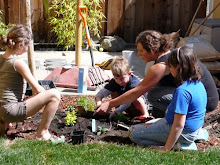
amidst the mass of nationally distributed eco building product manufacturers, newly established prefab architects, airstream trailers, and roaming designers found at the san francisco concourse center this year, was a humble duo of bay-local, edible landscapers standing alongside thier uniquely angled planter boxes made from salvaged door jams containing a combination of native edible plants, fruits, and vegetables.
our passers-by exceeded our expectations with their genuine handshakes, raised eyebrows, and vocalized enthusiasm about landscaping with edible plants and whats more, their interest in high density agriculture in urban environments.
a lot went on behind the scenes of our display at dwell that i feel should be noted somewhere, for the sake of humor, hard-work, acknowlegement, and insight into the core of all edibles. i have chosen this blog to be that place. please read on!
1. where there would have been two industry-style doors opening to a bland parking lot, there were two industry-style doors opening to an outdoor oasis of landscaped splendor - greenery of all shapes, sizes, and shades, winding gravel pathways, salvaged mirror walkways, unique built structures, artistic fountains, outdoor furniture. people smiling in the sunshine, interacting with strangers, laughing out loud, curiously inspecting materials and visualizing them in their own exterior space. this space was made possible in a mere couple of days with the sweat of a handful of individuals. if energy was focused more often in this way, imagine all of the undervalued urban spaces which could be activated and converted to create a similar atmosphere for anyone who happened by. this is the kind of activism that spurs me - inspiring community with beautiful spaces.
2. kirk and i did not sleep a lot in preparation for this event. we were up several late nights responding to design changes, creating marketing materials, arranging the logistics of truck borrowing and material pick ups, sawing wood for planter boxes (measure twice, cut once), drilling wood, staining wood, buying plants from three different vendors, and on and on. we were stress balls, navagating our schedules around day jobs and some sort of loosely held definition of sanity ... the night of the install we found ourselves a volunteer work crew comprised of our wonderfully supportive, helpful, crafty, construction saavy, and attractive significant others - who else would elect themselves for manual labor until the wee hours of the morning under a tight deadline?! but we got it done! at 4 am. suffice it to say, all four of us experienced a subtle hint of delirium. we really owe those two.
3. because the install was a temporary one, purchasing and hauling soil to fill the two-foot deep planter boxes would not have been an economical choice. we decided instead to replace soil volume with strategically placed packing peanuts, stray pieces of wood, bubble wrap, and cardboard boxes (maybe a few empty corona bottles) - a surface on which to arrange still potted plants surrounded by a thin spread of mulch covering. to the eye of the beholder, these makeshift elements were unseen - the "wizard behind the curtain", so to speak. this was the goal, of course, but it is important to note that the placement of these items beneath the mulch was, in fact, an art - a hidden masterpiece. i would liken it to a high-scoring game of tetris or jenga, as the fitting of these various shapes and textures had to be seamless because any gaps would create an escape route for the mulch (of which we had a limited supply). lucky for us, it is commonplace for members of our generation to be very skilled at tetris.






